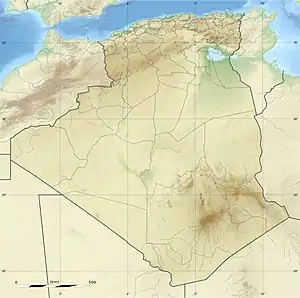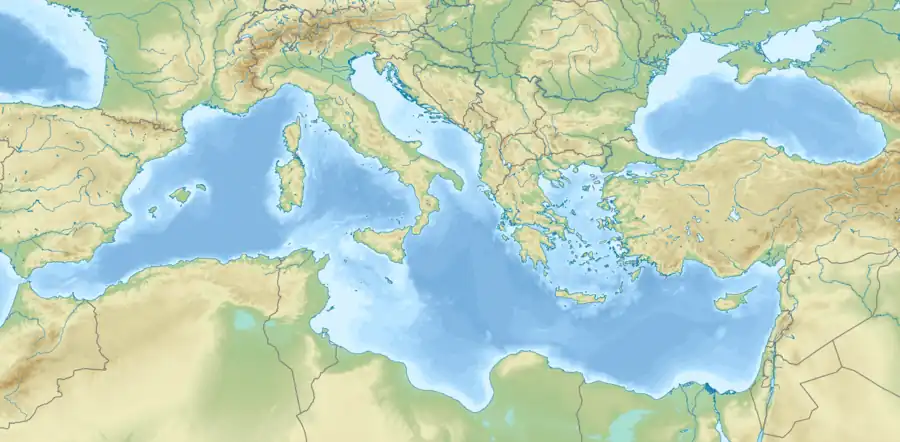| Collo Massif | |
|---|---|
 Collo Massif  Collo Massif | |
| Highest point | |
| Peak | el Goufi |
| Elevation | 1,183 m (3,881 ft) |
| Coordinates | 37°0′N 6°25′E / 37.000°N 6.417°E |
| Geography | |
| Country | Algeria |
| Region | Skikda, Jijel |
| Parent range | Tell Atlas |
The Collo massif, sometimes called Kabylie de Collo, is a mountainous forest massif of Algeria located in the north-east of the country and constituting part of the Tell Atlas.
Geography
Geographers distinguish several "Kabylies": Great Kabylie, Small Kabylie and Kabylie of Collo or Numidic Kabylies.[1] The latter, located west of Annaba and north of Constantinois, is the most watered region of Algeria, with more than 1,200 millimetres (47 in) per year. The average annual rainfall on el Goufi mountain, west of Collo, is 1,800 mm (71 in).[2] The climate is humid Mediterranean.[3]
The Collo Massif, a segment of the Tell Atlas, is heavily forested. Lying between the Skikda Valley in the east and the Rhumel River in the west and strongly advancing towards the Mediterranean Sea: the Cap Bougaroûn, is the northernmost point of Algeria.[4]
It consists of small mountains of modest altitude culminating between 900 and 980 m (2,950 and 3,220 ft) and dominated by cork oak, as well as the replanting of maritime pines[3] which provide 30% of national cork production. Several wadis in the region have their source there: Rhummel, Oued-el-Kebir and Saf-Saf,[1] forests are lined with fertile plains.[4]
Population
The population of the Collo massif was a peasant society in the full sense of the term: a complete sedentary lifestyle, a strong attachment to the land, a careful development. Its social structure was strong, governed by customary rules, the land was privatized with status melk.[5]
The Collo massif is, like the Small Kabylie and the Edough, populated by Arabized Berbers long-time but leading a sedentary life. The mountain people practice cattle breeding. Goats and sheep provided supplements (milk, flesh and hair) to poor agriculture.[6] Demographic densities are significantly lower than those of the Grande and Petite Kabylies.[1]
References
- 1 2 3 E.B. et M. Dahmani, « Kabylie : Géographie », in Encyclopédie berbère, 26 | Judaïsme – Kabylie, En ligne, mis en ligne le 1 juin 2011, consulté le 10 août 2015.
- ↑ G. Camps, « Babor », in Encyclopédie berbère, 9 | Baal – Ben Yasla, En ligne, mis en ligne le 1 décembre 2012, consulté le 10 août 2015.
- 1 2 Marie-Françoise André, Du continent au bassin versant: Théories et pratiques en géographie physique, Presses Univ Blaise Pascal, 1 janvier 2007, 592 pages, p.562, lire en ligne.
- 1 2 Côte, Marc (1996). Guide d'Algérie: paysages et patrimoine. Média-Plus. p. 171. ISBN 9961-922-00-X.
- ↑ Hamid Ait Amara, « La question agraire aujourd’hui », Insaniyat / إنسانيات En ligne, 7 | 1999, mis en ligne le 31 mai 2013, consulté le 7 juillet 2015.
- ↑ E.B., « Edough », in Encyclopédie berbère, 17 | Douiret – Eropaei En ligne, mis en ligne le 1 juin 2011, consulté le 7 juillet 2015.